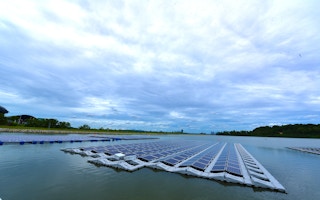What’s flat, floats on water, and converts sunlight into energy?
To continue reading, subscribe to Eco‑Business.
There's something for everyone. We offer a range of subscription plans.
- Access our stories and receive our Insights Weekly newsletter with the free EB Member plan.
- Unlock unlimited access to our content and archive with EB Circle.
- Publish your content with EB Premium.
A lily pad - which Singapore’s newly-announced floating solar photovoltaic (PV) cell test bed will mimic in action when it becomes operational by the end of the year.
Ten different solar energy or PV systems and a variety of flotation devices have been installed for this one-hectare pilot project that bobs along the surface of Tengeh Reservoir in Tuas in the west of Singapore.
The test bed is meant to uncover which is the most cost-effective and efficient PV cell technology for use in Singapore, and the environmental impact of floating PVs on the island’s water bodies. It will also test to see if the performance of the solar panels will improve due to the cooling effect of the water.
The first of its kind in the world for the range of flotation systems and PV technologies on trial, it is the centrepiece of a study led by the Economic Development Board and national water agency PUB, and managed by the Solar Energy Research Institute of Singapore (SERIS).
A 20 kilowatt peak roof-top system has been built nearby as a control.
Minister for the Environment and Water Resources, Masagos Zulkifli, unveiled the project at the joint opening ceremony of this year’s Asia Clean Energy Summit and Photovoltaic Science and Engineering Conference held at the Sands Expo and Convention Centre last week.
“
The introduction of the floating test bed goes hand in hand with Singapore’s SolarNova Programme, launched in 2014 to raise solar generation capacity to 350 megawatt peak by 2020.
“If this pilot successfully establishes the economic viability and environmental sustainability of floating solar PV systems, Singapore will explore the large-scale deployment of these systems,” he said.
In his opening address, Masagos added that sustainability should not be considered as an alternative or a trade-off to economic development. “Rather, the pursuit of clean and renewable energy development is a venture into greater opportunities and growth, and also a necessary step into the new green era.”
The test bed currently has a capacity of about one megawatt peak. A megawatt peak is a unit of measure used specifically for solar power.
At the end of the first phase of testing, two of the best-performing PV technologies will be tested on a larger scale during the second phase of the project and deployed for a larger two megawatt peak trial in 2017.
As a country facing land scarcity issues and high population density, Singapore has very little recourse when it comes to generating its own renewable energy. But because it receives sunshine all year round, the country has identified solar energy as the most promising type of renewable energy for its needs.
Dr Thomas Reindl, deputy CEO and cluster director for solar energy systems at SERIS, said floating solar PV systems are trending in regions that have “under-utilised water surfaces available or where land is very expensive”.
While floating PV systems have been installed in countries like Japan and the UK, there have been few studies assessing the technical, economic, and environmental consequences of deploying systems on a large scale, he added.
SERIS’ own floating solar PV monitoring technology will be used to keep track of the performance of the test bed in real-time, and will be useful for offshore floating PV systems in the future.
Goh Chee Kiong, executive director for cleantech at EDB, said: “As a highly dense city state with limited space for solar deployment, Singapore is placing emphasis on building up urban solar capabilities which include floating solar as a key focus area.”
Singapore’s floating PV test bed will serve as reference for companies both local and international to “scale up their technologies for global markets”, added Goh.
Solar Singapore
The introduction of the floating test bed goes hand in hand with Singapore’s SolarNova Programme, launched in 2014 to raise solar generation capacity to 350 megawatt peak by 2020 from 19 megawatt peak that year. Six thousand public buildings including public housing, schools, police stations, and utility plants will have solar panels fitted on their rooftops under the SolarNova Programme.
Adopting solar technology in energy production will help Singapore to achieve its 2030 carbon mitigation target and strengthen its resilience to climate change.
According to SP PowerGrid, Singapore had 59.5 megawatt peak worth of solar panels installed in 2015.








